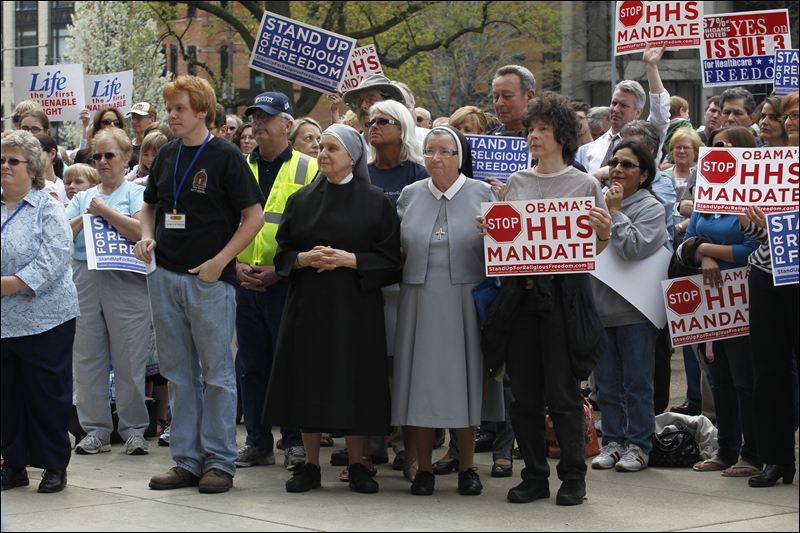
Saw in the news on Friday (3/23), in various cities across the country, the Catholic church organized members to protest the upcoming contraception coverage mandate that is part of the Affordable Care Act. Under the guise of religious freedom, Bishops, nuns, and others – mostly men – complained about the mandate. The problem is their protest was for the wrong reason and made them look silly.
At one such protest in Toledo Ohio:
Bishop Blair, the keynote speaker at the noon rally, said he perceives a “very frightening” erosion of religious liberty in America today that poses a threat to all religions and volunteer groups, not just the Roman Catholic Church.
“First of all, it’s not about the religious freedom of Catholics only, but all of those who recognize that their cherished beliefs might be next on the block,” the bishop said.
And it’s not about access to contraception, Bishop Blair asserted, adding that “contraception is ubiquitous and inexpensive in our country even when it’s not provided by the church’s hand or with the church’s funds.”
The U.S. Conference of Catholic Bishops has been strident in its opposition to the health-care mandate ever since the Department of Health and Human Services issued the new rules on Jan. 20 as part of the Affordable Care Act. One point of contention is the government’s limited exemption for the coverage, affecting only religious groups that hire and serve those who share the same religious beliefs. That excludes the vast majority of Catholic hospitals and universities.
Bishop Blair, like all the people who are protesting, don’t understand how health insurance or the mandate works. The mandate doesn’t force nuns or other Catholics to *USE* contraception although surveys show 98% of catholic women do use it. Also Catholics and non-catholics who work for catholic hospitals and universities pay into their insurance plans so covering contraception should be part of the plan – that is all the mandate is mandating. It’s to allow women who wish or need to use contraception the ability to get it without paying a co-pay (the out of pocket part of the cost most insurance plans require these days).
Contraceptive use is essentially universal in the United States: Ninety-eight percent of sexually experienced American women have used a method at some point in their lives. However, many women face problems in using contraceptives or using them consistently. Among the 43 million women at risk of an unintended pregnancy in 2002, 6% did not use a method all year, 10% had a gap in use of at least one month and 19% reported inconsistent use (e.g., skipped pills). This behavior has clear consequences: The one-third of women who do not use a method or who use one inconsistently account for 95% of unintended pregnancies.
Although there are myriad reasons behind these distressing statistics, cost is one important barrier. Brand-name versions of the pill, patch or ring can cost a woman upwards of $60 per month if paid entirely out-of-pocket, not including the cost of a visit to a health care provider. Long-acting or permanent methods, such as the IUD, implant or sterilization, are most effective and cost-effective, but can entail hundreds of dollars in up-front costs.
These costs affect individual women’s behavior. A national survey from 2004 found that one-third of women using reversible contraception would switch methods if they did not have to worry about cost; these women were twice as likely as others to rely on lower-cost, less effective methods. According to another recent study of 10,000 women in the St. Louis area, when offered the choice of any contraceptive method at no cost, two-thirds chose long-acting methods—a level far higher than in the general population. Findings like this help explain why rates of unintended pregnancies are far higher among poor and low-income women than among their higher-income counterparts.
Insurance coverage is designed to help people overcome these financial barriers. One-quarter of uninsured Americans went without needed care in 2009 because of cost, versus 4% of privately insured adults. And according to three recent studies, lack of insurance is significantly associated with reduced use of prescription contraceptives.
Yet, cost-sharing poses a significant problem even for women who are insured. A 2010 study found that women with private insurance that covers prescription drugs paid 53% of the cost of their oral contraceptives, amounting to $14 per pack on average. What they would pay for a full year’s worth of pills amounts to 29% of their annual out-of-pocket expenditures for all health services.
The Case for Insurance Coverage of Contraceptive Services And Supplies Without Cost-Sharing
The greater good – a secular good – is to provide coverage and many Catholic universities and hospitals already cover contraception in their health insurance plans and 28 states require coverage as well.
Real Religious freedom would be not allowing the Bishops, nuns, and other religious people to force themselves into the private personal health matters of other people under the religious freedom ruse.
After observing the number and energy in the protests, just imagine what could’ve happen if the Catholic Church had worked this hard to safe guard all the children who were abused over the years by priests and nuns?? Somebody’s priorities are mixed up.